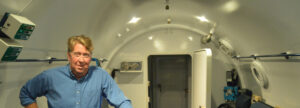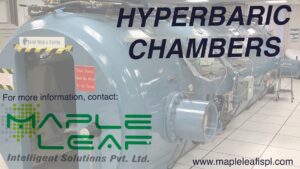
Hyperbaric Chamber Source: Wikimedia Commons
HYPERBARIC CHAMBERS
Our species, as a biological entity, is aerobic in nature and hence, for survival, oxygen is essential. In the event that the cells in the body are deprived of oxygen, irreparable damage occurs even resulting in a fatality. This article addresses an effective tool of healthcare, namely, HBOT hyperbaric oxygen therapy.
There are typical diseased conditions where the starvation of oxygen occurs in the cell aggregates of the body. Some illustrative examples are gangrene, carbon monoxide poisoning, and persistent wounds with a delayed healing profile. HBOT is particularly useful in these conditions. Hyperbaric oxygen therapy is a common line of treatment for scuba divers suffering from a condition known as decompression sickness. Erratic pulse rate, nausea, delirium and hypothermia in scuba divers are addressed by HBOT.
“Hyper” means heightened, and “baric” refers to pressure… hence, a hyperbaric chamber is a confined space in which the pressure is higher than usual. It follows that the solubility increases for O2 that the subject inhales. Conditional cyanosis and reduced tissue oxygen are thus corrected.
How does Hyperbaric Chamber work?
The tissues in the human body need oxygen to function. The air we breathe is 21% oxygen.
HBOT involves breathing 100 percent pure oxygen while in a special space called a hyperbaric chamber. The air pressure inside the chamber is raised to a level that is higher than normal air pressure.
The increased air pressure in the chamber helps the lungs collect more oxygen. Getting more oxygen to the tissues that need it can help the body heal and fight certain infections. However, too much oxygen can cause damage to the body.
This treatment is centric on the breathing of pure oxygen in a pressurized and contrived environment. Hyperbaric oxygen therapy can increase circulation and oxygenation. The pressure of air is increased two to three times higher than normal air pressure. Naturally, the lungs can accept larger volumes of oxygen, which in turn reach the cells to fight infection and accelerate the healing process.
The procedure of the therapy is simple. The patient is exposed to a time span of three minutes to around one and a half hours. During this time the patient is asked to lie supine in the chamber environment. The medical practitioner decides the frequency of the sessions for each patient and careful monitoring of the case is an important part of the therapy.
Interestingly, Hyperbaric chambers are proving particularly useful in the clinical intervention of Alzheimer’s disease and other forms of mental degeneration. Several subjects show considerable improvement and the results are both sustainable and encouraging. Research findings support the use of HBOT in the delay of the aging process in the human body. Hyperbaric Chambers are also used by professional sportspersons for recovery. Novak Djokovic uses the hyperbaric chamber, to speed up recovery after long matches.
Risks of hyperbaric oxygen therapy
While HBOT is generally safe, there are some serious complications that are rare.
Due to the the increased pressure and increased concentration of the oxygen during HBOT, potential risks include:
- Ear and sinus pain
- Middle ear injuries, including tympanic membrane rupture
- Temporary vision changes
- Lung collapse (rare)
High concentrations of oxygen also pose the risk of fire.
Barotrauma refers to damage to the ear due to increased pressure. Barotrauma of the ear is the most frequent complication of HBOT.
It is important to note that in the case of upper respiratory and pulmonary disease, supplemental oxygen does not play a curative role, but it is a significant line of treatment that improves symptoms and organ function on the whole.
There are some dos and don’ts for HBOT. No chewing of gum or candy is permitted as also the use of the mobile phone. Volatile cosmetics that vaporize are prohibited. Any detachable accessories like spectacles, jewelry, and watches are strictly prohibited. Due to the serious implication of Oxygen deprivation in the COVID-19 cases, many research endeavors have been undertaken and actualized in the backdrop of the Pandemic, in the global context. Obviously, the use of HBOT in the management and treatment of COVID-19 was undertaken as a kind of limited context alternative.
The author acknowledges the use of authentic medical literature to structure this article.
Sign up for the QuackTrack.org newsletter below!
















Sadashiv Deshmukh Aurangabad
April 15, 2022 at 10:38 am
Very useful therapy especially in body is in degenerative state ..must be performed under doctors guidance to avoid side effects. Thanks